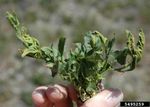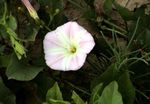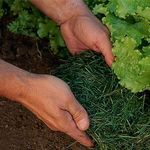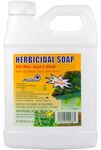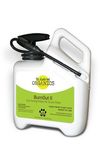Vegetable Garden Weed Management - Tony Koski, Extension Turf Specialist - Colorado Master ...
←
→
Page content transcription
If your browser does not render page correctly, please read the page content below
Vegetable Garden Weed Management
Tony Koski, Extension Turf Specialist
Weeds compete with vegetables for light, water and nutrients, can interfere with harvesting and may increase
the potential for vegetable disease problems. Complete elimination of weeds in the vegetable garden is neither
realistic nor necessary. Effective weed management can employ several strategies, depending on weed species
involved and personal preferences regarding use of pesticides and other weed management tools.
Understand the Sources of Weeds
Weed seed exists in all garden soils
Manure, compost, and other soil amendments often contain weed seed
Imported topsoil will always contain weed seed (no matter claims to the contrary), and may contain
rhizomes, bulbs and other plant parts that may grow into a weed
Plant-based mulch materials (straw, hay, grass clippings) may contain weed seed
Weed seed can be moved into gardens by wind, water, humans or animals
Weeds may move from other areas of your landscape, adjacent fields, neighboring landscapes by above-
(stolons, runners) or below-ground (rhizomes) laterally growing stems
It is impossible to prevent or eliminate weeds – but persistent, proper management can result in a nearly
weed-free vegetable garden
Soil disturbance (tilling, digging, hoeing, pulling weeds, foot traffic) encourages weed seed germination
Preventing Weed Growth
Weed prevention is always preferable to (and easier than) having to manage weeds after they have begun
growing. Prevention involves a combination of practices – cultural and chemical (optional) – which create
conditions unfavorable for weed growth.
Cultivation Practices
Soil disturbance encourages weed seed germination by exposing buried seed to
light – a stimulus for seed germination (buried seeds don’t germinate)
Consider preparing soil (tillage, amendment incorporation) for planting 3-4
weeks prior to planting and control emerging weeds (“fallowing”)
o As weeds emerge, but prior to planting, cultivate SHALLOWLY to kill
seedling weeds
o Kill emerging weed seedlings with synthetic or “natural” herbicides (see
below)
o Kill emerging weed seedlings by flaming (see below)
If herbicides or flaming aren’t options, mulch immediately following tillage
If soil doesn’t require amendment prior to planting, consider use of a broadfork
to loosen soil (this reduces weed seed movement to the surface of the soil)
Colorado State University, U.S. Department of Agriculture and Colorado counties cooperating. CSU Extension programs are available to all
without discrimination. No endorsement of products mentioned is intended nor is criticism implied of products not mentioned. Carefully
read and follow all pesticide label instructions; the label is the law and you are liable for any damage or misuse (intentional or accidental).
Written 6/2014; revised 3/2018.Plant Spacing
Use recommended plant spacing to create competition for weeds
Consider the use of block planting to increase competition against weeds
The critical weed-free period for most warm-season vegetables is about 45
days after planting, after which time plant canopy will be big enough to
shade the weeds and inhibit their growth. Thus, early-season weed control
is critical
Squash, corn, potatoes, cabbage, broccoli, tomatoes are strong competitors
against weeds
Lettuce, carrots, peppers, onions, peas, radish are poor competitors against
weeds
Mulch
Will smother existing weeds and/or prevent
germination of weed seeds
Grass clippings are ideal mulch for vegetable gardens
Hay and straw can be effective mulch, but may
introduce weed seeds to the garden
Wood chips and sawdust should be used sparingly;
their decomposition can increase the need for
nitrogen
Newspaper and cardboard can be used between rows
(must be weighed down)
Plastic mulch can be used to increase soil temperature
for warm-season crops
All mulches will reduce water loss and irrigation needs
(especially plastic mulch)
Irrigation Practices
Overhead sprinkler irrigation, which also applies water to soil
where plants are not growing, will encourage weed growth
Drip irrigation wets a lesser amount of soil and encourages less
weed growth
When drip irrigation and mulch are used together, weed
problems in the vegetable garden are significantly reduced
Use of drip irrigation will reduce the potential for disease
occurrence and spreading of disease pathogen by splashing
Drip irrigation will produce equivalent yields but uses less water
than overhead irrigationThermal Weeding (flaming, steam, boiling water)
Used on fallowed seedbeds before vegetable seedlings emerge
Can be used between rows after vegetable emergence
Burning and/or fire hazard is an obvious concern
Most effective on seedling broadleaf weeds; less effective on
grasses and sedges
Not effective on perennial weeds unless repeated
Solarization
Soil is covered with clear plastic (gets hotter than black plastic) for 4-6
weeks to kill weeds, weed seeds, and some plant pathogens
Can be very effective if done during warmest time of the year
Garden can’t be used during solarization process
Any subsequent tillage will bring weed seeds to surface (only seeds in
surface 2-3 inches will be killed)
Herbicides for Use in Vegetable Gardens
Synthetic
Glyphosate (Roundup, Kleenup, many other names)
o Non-selective; postemergence
o Systemic; good for perennial weed control
o No root activity; no soil residual
o No activity on seeds
Trifluralin (Preen)
o Preemergence
o Kills germinating seeds
o Will not control weeds you can see
o Short residual (6-8 weeks)
o Soil disturbance will reduce effectiveness
“Natural”/Organic
Corn gluten meal (CGM)
o VERY limited preemergence activity – if any
o Short residual (4-6 weeks), if any
o Contain 10% nitrogen
o Rates and application frequency recommended for
weed control may encourage excessive vegetable
growth
Soaps, essential oils, acetic acid, iron sulfate
o Non-selective (can damage desirable plants)
o Disrupt leaf cuticle; burns leaves
o Not systemic; full coverage of weed is essential
o Most effective on seedlings; PERENNIALS WILL GROW
BACK
o Must be reapplied for control of larger/perennial weedsManaging Difficult Perennial Weeds in the Home Landscape
The four most difficult weeds encountered in the home landscape – lawns, vegetable
gardens, flower and shrub beds – include four perennial weeds: bindweed, Canada
thistle, quackgrass and bermudagrass. Though these are very different species, they
behave similarly as weeds in the landscape. All are non-native, deep-rooted
perennials that spread by underground rhizomes (bermudagrass also spreads above-
ground by stolons or runners). While all can produce seed, the main way that they
d spread in the landscape is by their laterally growing stems. They all can survive – and
nsis) even thrive – without any supplemental irrigation and will persist through the longest
and most severe droughts because all four produce extremely deep roots (as deep as 6 feet or more). The key to eradicating
these perennial weeds is to interrupt/prevent photosynthesis and depleting stored energy by forcing the plant to
continuously produce new shoots, leaves, and roots. By reducing the plant’s ability to re-supply underground energy
reserves via photosynthesis, it uses up energy by constantly re-growing new leaves, stems, and roots.
MULCHING prevents photosynthesis and forces the plant to use energy to push leaves and stems through the mulch layer
Deeper mulch (3-6 inches) is more effective
Sheet mulching (using newspaper or cardboard) under a layer of soil or other mulch can be very effective – but
weeds will grow laterally and emerge at the borders of the sheet mulched area
Pull/cut plant tops (or spray with appropriate herbicide) as soon as they grow through the mulch
Persistent, diligent removal of new growth that emerges through and at the borders of the mulch will result in
successful control – but this may take years (especially if herbicides are not used)
CULTIVATION (plowing, tillage, hoeing, pulling) can be effective if performed diligently and persistently through consecutive
growing seasons
Will be more effective if done in conjunction with herbicides
Cultivation will disturb the weed seed bank and may lead to other weed problems
SOLARIZATION can be an effective tool for managing these perennial weeds
Subsequent tillage of a solarized area may result in germination of
buried, unkilled seeds
Weeds can still infest the solarized area from its borders
BIOCONTROLS
Biocontrols never result in total eradication of the weed; rate of
weed population reduction can be slow
There are no biocontrols for quackgrass or bermudagrass
Bindweed mite (Aceria malherbae) can be effective where
bindweed receives no irrigation
For more information on using bindweed mites go to:
http://www.colostate.edu/Dept/CoopExt/Adams/weed/bindweed_mite.html
HERBICIDES can be effective when used with the above management tools
Glyphosate (Roundup, Kleenup, many other product names) is the only synthetic POSTEMERGENT herbicide that
can legally be applied to vegetable gardens by the home gardener for control of these perennial weeds
Glyphosate can provide excellent perennial weed control when used with mulching and cultivation practices
Corn gluten meal will be ineffective for managing perennial weeds, and may increase their aggressiveness because
nitrogen in CGM may stimulate weed growth
Use of acetic acid/vinegar and other “natural”/organic weed control products will only be effective if used
repeatedly and in conjunction with other management tools described aboveYou can also read





